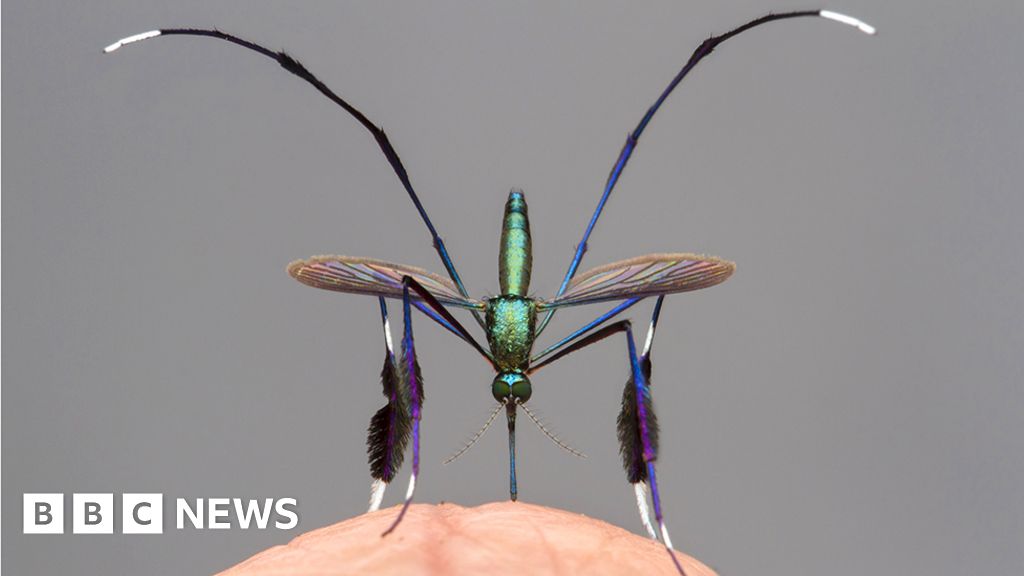By Jonathan Amos
BBC Science Correspondent
You can not enable but marvel at its beauty. This woman mosquito, with its incredible furry legs and iridescent shimmer, is a total stunner.
It truly is one of the Sabethes species discovered in central and South America.
What a shame this certain specimen also happens to be an vital provider of tropical ailment.
Scroll down this web page and you can love some of the other really commended photos in what is the 57th yr of the prestigious contest.
Gil is an entomologist by teaching, so he actually understands his topics. And to get this sort of shot involves a ton of organizing, patience – and even some suffering.
He describes Sabethes mosquitoes as becoming extremely skittish and hard to photograph properly, primarily in the continuous warmth and humidity of the Amazon rainforest in Ecuador, where by this photograph was taken.
“The mosquito responds to the tiniest of movements and to adjustments in light intensity,” he explained to me.
“This suggests you have to keep extremely still while attempting to photograph it, and also be geared up for the mosquito’s escape if applying a flash. The good news is, you are never ever by itself with a one mosquito, simply because commonly there are dozens of them hovering above your head.
“These mosquitoes are essential vectors of a number of tropical health conditions, such as yellow fever and dengue fever. Even though getting the photograph, I was bitten by this mosquito and many some others, escalating the risk of contracting a vector-borne tropical disease. But I am even now alive!”
Any person who’s at any time tried to just take an insect photo will recognise that Gil has had to “stack” numerous differently focussed photos to get the depth of field important to exhibit all of the detail together its overall body.
Storm fox by Jonny Armstrong, United states
A vixen queries for salmon carcasses in the shallows of Karluk Lake in the Kodiak National Wildlife Refuge of Alaska
Notice how the mosquito’s rear legs are held significant as it feeds on blood from Gil’s knuckle. They’re sensory. The insect desires to remain hyper-conscious of what is going on all over it just in circumstance there is a necessity to make a quick escape.
And then, of program, there are these feathery “paddles” on the other legs. Their reason is not totally very clear but are probably involved in attracting a mate.
There are more than 3,300 species of mosquito in the environment. They have number of admirers.
Most of us will not likely end to look at them near up when we swat them. But if we did, we would uncover many exhibit colourful scales and hairs, claims Erica McAlister, a senior curator at London’s Purely natural History Museum, which operates the WPY competitiveness.
To some diploma or other, every thing has its place in mother nature.
“The female Sabethes is only heading to blood-feed when she’s about to make eggs. The relaxation of the time she nectar feeds. Hence, she will be a pollinator,” Erica points out.
“You have to try to remember she’s currently being manipulated by these viruses (dengue and yellow fever). Which is one way to appear at it.”
Gil’s graphic is titled Gorgeous bloodsucker. Down below are some other very recommended photos.
Mushroom magic by Juergen Freund, Germany/Australia
A glowing fungus clings to a useless tree in the rainforest of Queensland, Australia. Click on the image and you can see some online video as perfectly
The terrific swim by Buddhilini de Soyza, Sri Lanka/Australia
Potent swimmers. Male cheetahs paddle across the flood-swollen Talek River in Kenya’s Maasai Mara
Harmful structure by Gheorghe Popa, Romania
A drone appears down on a polluted river in the Geamana Valley, within Romania’s Apuseni Mountains
Lockdown chicks by Gagana Mendis Wickramasinghe, Sri Lanka
3 rose-ringed parakeet chicks pop their heads out of a nest hole as their father returns with food stuff. This photo was taken by 10‑year-aged Gagana from a balcony at his property in Colombo
The in general winners in the Wildlife Photographer of the 12 months competition will be declared at an awards ceremony on Tuesday 12 Oct. The once-a-year NHM exhibition will open up the pursuing Friday, 15 October, and, as regular, will then go on tour.

